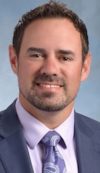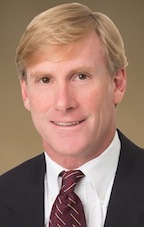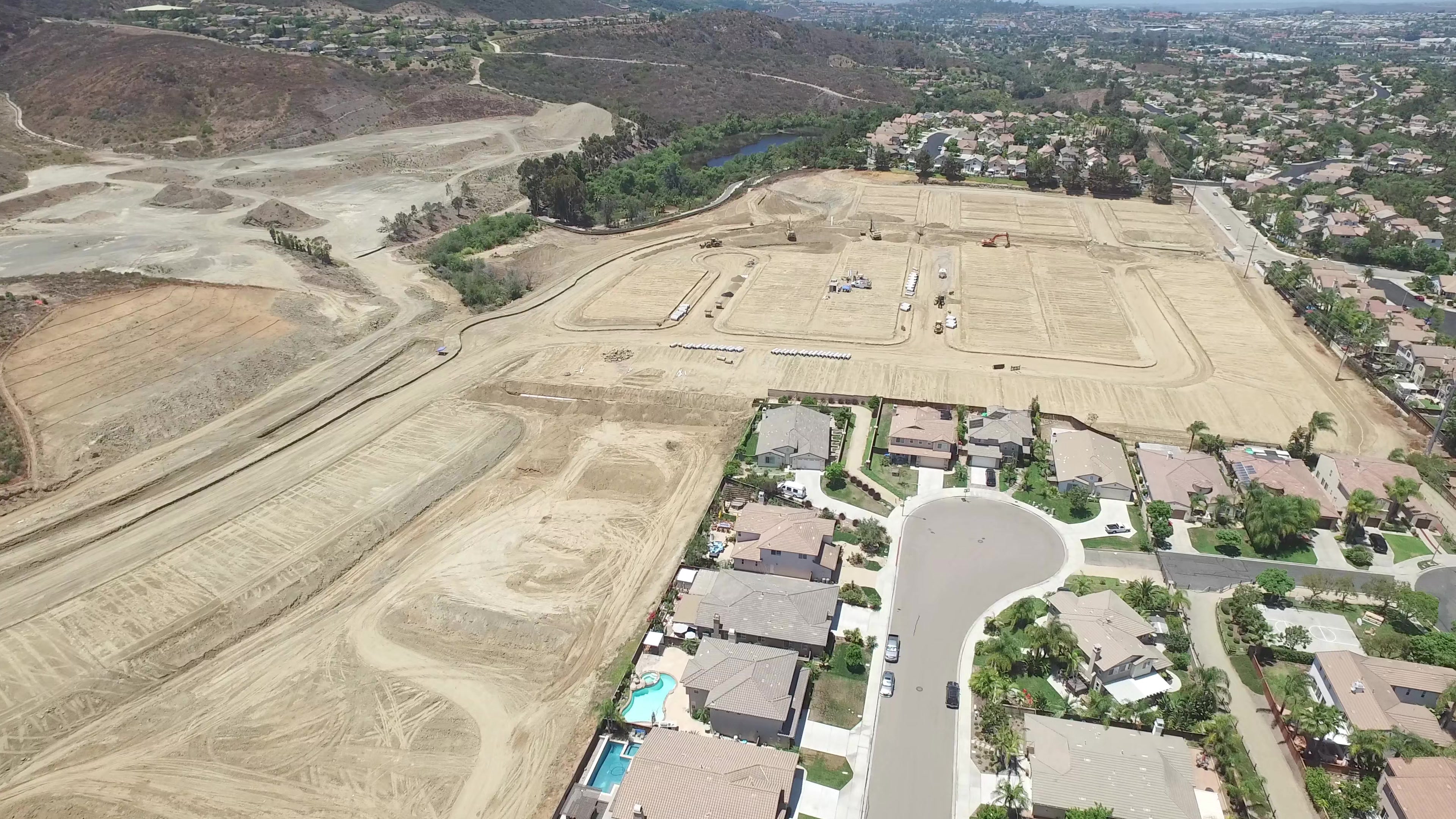Daily Business Report-Aug. 5, 2016
Site of the Rancho Tesoro community in San Marcos. (Courtesy Brookfield Residential)
Construction Begins on Brookfield Residential’s
New Master Planned Community in San Marcos
Grading and land development efforts are underway near Twin Oaks Valley Road and Village Drive in San Marcos, the location of Brookfield Residential’s new master planned community spanning more than 250 acres. The homebuilder and developer along with homebuilding partner California West Communities will debut this planned community — called Rancho Tesoro — in spring 2017.
The community is located near Discovery Lake — which can be accessed through the extensive trail system — and is driving much of the nature-oriented design.
Rancho Tesoro will showcase four neighborhoods — three behind vehicular gates. The 347 detached homes will include private yards, four to five bedrooms, and two- to three-car garages. Homes will range in size from approximately 2,211 to 3,565 square feet.
Proposed private recreational amenities at Rancho Tesoro include a pool, barbecues, picnic tables, a covered trellis pavilion, neighborhood parks and access to multiple trails for walking, jogging and bicycling.
The community is located south of State Route 78.
________________________________________
Gov. Brown Signs Tribal Compact
With Jamul Indian Village for New Casino
After years of controversy, Gov. Jerry Brown on Thursday signed a tribal-state gaming compact between the State of California and the Jamul Indian Village for the Hollywood Casino Jamul-San Diego that is currently under construction and set to open later this summer.
“JIV is very grateful to Governor Brown for making this agreement possible,” said Erica Pinto, Jamul Indian Village chairwoman. “The compact creates an economic environment that allows the tribe to transition to self-sufficiency and to contribute to other tribes, the community and local government.
The tribe’s efforts to build a casino have been a source of controversy for the past several years, with several Jamul residents, including county Supervisor Dianne Jacob, opposing the project.
“Hollywood Casino is preparing for its big debut, but the place isn’t ready for prime time,” said Jacob, whose district includes the Jamul Indian Village. “The construction of the casino is already taking a terrible toll on all those who travel rural, two-lane Highway 94, and the state is making matters worse by not requiring Jamul Indian Village to fully construct highway improvements before opening.
“The fault lies with state officials who negotiated a compact behind closed doors, issued a liquor license and hastily green-lighted a project that does nothing to ensure the safety of drivers on an already dangerous highway.”
The compact term is 25 years and, among other things, includes contributions to protect wildlife and habitat.
The compact also provides incentives that will allow the tribe to continue to partner with and invest in the local community. “Through this compact, JIV reaffirms its commitment to working with the county on fire service, law enforcement and road improvements,” said Pinto. “The tribe also seeks to develop projects designed to preserve historical buildings, landmarks and objects of cultural significance that provide a mutual benefit to the tribe and the local community.”
The Hollywood Casino Jamul-San Diego is expected to employ more than 1,000 permanent workers, and will include a three-story gaming and entertainment facility featuring slot machines, live table games, multiple restaurants, bars and lounges and an enclosed parking structure.
________________________________________
Plan to Remove Car Traffic
From Balboa Park Clears First Hurdle
By City News Service
A revived plan to remove vehicle traffic from the center of Balboa Park cleared its initial hurdle Thursday when the City Council’s Infrastructure Committee approved spending $1 million to complete planning and documentation.
The plan envisions shutting off traffic in the Plaza de Panama, Plaza de California and Esplanade areas of the park, constructing a vehicle bypass bridge and building a parking garage behind the Spreckels Organ Pavilion.
The City Council first approved of the project four years ago, but it was overturned by a judge on a technicality. The city later won an appeal, and Mayor Kevin Faulconer recently revived the idea.
During the intervening time, parking areas have been taken away from the Plaza de Panama. The open area between the Museum of Man and El Prado cultural institutions has been spruced up with seating areas and landscaping, but there are still conflicts between moving vehicles and pedestrians.
The unanimous committee action, which needs approval by the full City Council next month, would give the project a place in the city’s capital improvements budget for this fiscal year.
“Although it is a priceless San Diego treasure, there is quite a bit of deferred maintenance as most of us are aware, and I think if we want the park to be around for our grandchildren, we need to certainly up our game when it comes to investment,” committee Chairman Mark Kersey said.
According to city staff, it appears the entire project will cost around $70-75 million, with the municipal contribution capped at $45 million and philanthropy covering the rest. A detailed financing plan is expected to go before the City Council in November.
Bruce Coons, the executive director of the preservation group Save Our Heritage Organisation, who sued to stop the original project and has vowed to fight it again, said city taxpayers will end up bearing the entire cost.
Vicki Granowitz, chairwoman of the North Park Planning Committee, said the plan was being “steam-rolled through” despite significant opposition.
“It actually doesn’t accomplish the things you want it to,” said Granowitz, who contended the parking garage would attract even more vehicles into the center of the park.
Jim Kidrick, president and CEO of the San Diego Air and Space Museum, called opponents the “usual naysayers” who always oppose new projects.
________________________________________
DARPA Taps Northrop Grumman-Georgia Tech Team
ExecutiveBiz
The Defense Advanced Research Projects Agency has awarded a $9.4 million grant to a Northrop Grumman-Georgia Institute of Technology partnership to develop a wireless monitoring method for Internet-of-Things devices.
Georgia Tech said the method will work to analyze side-channel signal emissions released by electronic devices that perform certain programs.
The Computational Activity Monitoring by Externally Leveraging Involuntary Analog Signals project tapped Milos Prvulovic and Alessandro Orso, both professors at Georgia Tech’s School of Computer Science, and a team of Northrop researchers led by Matthew Welborn.
The four-year project seeks to help researchers detect malicious software in a device through a comparison of unintentional side-channel emissions to existing data about the device’s normal operations.
“We will be looking at how the program is changing its behavior,” said Alenka Zajic, the project’s principal investigator and an assistant professor at Georgia Tech’s School of Electrical and Computer Engineering. “If an Internet of Things device is attacked, the insertion of malware will affect the program that is running, and we can detect that remotely.”
________________________________________

Engineers Receive SunShot Grant to Develop
Less Costly, More Efficient Solar Collectors
By Liezel Labios | UCSD
University of California San Diego electrical and computer engineering professor Boubacar Kante will lead a three-year, $2.5 million project funded by the U.S. Department of Energy SunShot Initiative aimed at making solar energy systems cost-competitive with traditional energy sources.
With this funding, the researchers plan to develop a new class of solar collectors — based on dielectric metasurfaces — that focus sun rays spanning a wider angular range and allow scaled-down, less expensive tracking systems.
The innovative project will be performed in collaboration with Sandia National Laboratories and will drive innovation to make solar energy systems cost-competitive with traditional energy sources.
“UC San Diego is known as the pioneer of metamaterials research and development. We are at the forefront of efforts to develop structured matter that can be used to control light at will. I am confident that, in collaboration with Sandia, we can leverage our advances in metamaterials research in order to develop less expensive and more efficient solar concentrator systems,” said Kante.
Solar collectors are optical systems that collect and concentrate sunlight onto a small area receiver. The concentrated light heats a thermal fluid, which creates steam to generate clean electricity. Today’s state-of-the-art solar collectors typically use curve-shaped (parabolic) systems to concentrate sunlight. But their curvature limits the range of angles of incoming sunlight that the solar collectors can capture. As a result, these systems must continually track the sun’s motion throughout the day. Funding for the new project will be used to design, develop and fabricate a new class of planar solar collectors that can operate over a broad spectrum of sunlight, thereby reducing the need for expensive continuous tracking systems.
“Critical success factors lie in the ability of this new technology to make use of most of the entire solar spectrum as well as its capacity for large-scale fabrication and integration. In this collaboration, we will address both these issues,” said Julius Yellowhair, a researcher from Sandia National Laboratories who will co-lead the project with Kante.
The goal of the proposed technology is to reach a cost to collection efficiency ratio ($/m2) of less than 0.91, which would be disruptive to current technologies as defined by the SunShot Initiative. Achieving a wider acceptance angle will relax some of the requirements placed on tracking systems and has the potential to significantly reduce the cost, researchers said.
Kante’s team has already made many contributions to the field of metamaterials, which involves developing materials that have properties that do not exist in nature. The researchers will leverage their recent findings on specially designed surfaces that can encode curvature into the phase of planar structured matter.
Sandia National Laboratories operates the National Solar Thermal Test Facility (NSTTF), the only facility of its kind in the United States with test capabilities for concentrating solar power (CSP) technologies. Sandia will perform on-sun testing of the prototype solar collectors. Sandia also has nano-fabrication capabilities, which it will use to fabricate and assemble meter-scale metasurface solar collectors.
If successful, the UC San Diego-Sandia solar collector design could provide solar thermal plants with a low-cost collector that is more efficient than current collectors.
“We are excited to tackle this challenge as the time has now come to use metamaterials for real world applications.” Kante said.
Read more…
________________________________________
Luxury Home Prices in San Diego County
Rise 13.2 Percent in the Second Quarter
Luxury home prices in San Diego County averaged $2.5 million in the second quarter of this year — a 13.2 percent increase from the same period last year, according to an analysis from Redfin. The average sale price for the rest of the San Diego market was $568,000 in the quarter, a 6.4 percent increase from last year’s second quarter.
Nationally, luxury home prices inched up 0.8 percent in the second quarter compared to last year, to an average of $1.66 million, according ro Redfin.
After market volatility sent luxury prices tumbling 1.1 percent in the first quarter, they found a footing in the second quarter as the global markets stabilized. While price growth in the high-end has been sluggish, home prices in the bottom 95 percent of the market have gained steadily around 5 percent each quarter for the past two years.
San Francisco has made Redfin’s luxury losers list for two straight quarters, with prices for the most expensive homes in the city falling 11 percent compared to a year ago. The market in San Francisco is shifting. Redfin data on June home sales indicate slowing price growth in the city after four years of double-digit inflation.
________________________________________
Change of Command for Navy
Special Warfare Command
Rear Adm. Tim Szymanski relieved Rear Adm. Brian L. Losey as commander of the Naval Special Warfare Command during a change of command ceremony at Naval Amphibious Base in Coronado on Wednesday.
Gen. Raymond Thomas, commander, U.S. Special Operations Command, was the guest speaker for the ceremony. In his remarks, Thomas praised Losey’s leadership: ”This ceremony commemorates the completion of 33 years of historic service for [Losey], most recently, three years of remarkable service here as commander, Naval Special Warfare Command. The global impact of this 9,000-member force under his command is hard to overstate.”
Szymanski said he was honored to take command of CNSWC from Losey.
The Naval Special Warfare Command is comprised of approximately 8,900 personnel, including more than 2,400 active-duty SEALs, 700 Special Warfare Combatant-craft Crewmen, 700 reserve personnel, 4,100 support personnel and more than 1, 100 civilians.
________________________________________
Personnel Announcements
Daniel Kehr Joins Best Best & Krieger

Daniel W. Kehr has joined Best Best & Krieger LLP as a partner to the Business practice group. Based in the firm’s San Diego office, Kehr provides corporate general counsel, technology, real estate, as well as trust, estate and succession planning legal services.
Prior to joining BB&K, Kehr managed his own law firm, Kehr Law. Kehr provides legal services for a variety of clients, including individuals, entrepreneurs, investors and bsinesses, including start-ups and mature companies, across a broad range of industries, such as technology, software, Internet, gaming, insurance, manufacturing, distribution, real estate and professional services.
Kehr attended the University of California, Los Angeles for his undergraduate studies. He was an NCAA intercollegiate baseball athlete. He earned his law degree from California Western School of Law in two years, and passed the California bar exam while studying for his master’s degree in tax law at the University of San Diego.
Alec Stephens Joins Kidder Mathews

Alec Stephens has joined Kidder Mathews’ San Diego office as a vice president specializing in multifamily investment sales.
Stephens has over 25 years of commercial real estate related experience as a principal, developer, and commercial real estate broker.
Prior to joining Kidder Mathews, he was with Commercial Facilities Inc. in San Diego.



